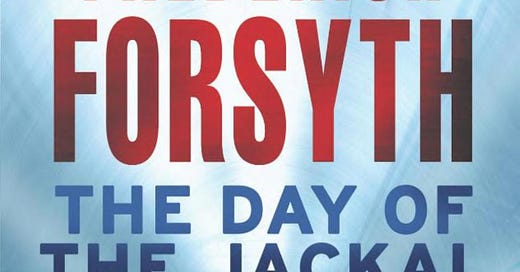Frederick Forsyth (1938–2025): The Wordsmith Cartographer who Mapped the World of Espionage
Suspense, State Secrets, and Cold War Mind Games—Thrillers that Played on our Nerves and Maps. Peerless?
By Karan Bir Singh Sidhu, retired IAS officer, writer, and lifelong devotee of precision prose. A fanboy Yadavindrian who first discovered Forsyth in a wonderfully musty school library—and never stopped ‘following’ his thrillers across the globe.
Frederick Forsyth (1938–2025): Architect of Real-World Thrills— Peerless?
A Death That Closes a Chapter
Frederick Forsyth, the writer who made global politics and covert operations the stuff of compulsive storytelling, has died at the age of 86. His passing brings to an end a life that seemed tailor-made for fiction, yet was lived with rare intensity and conviction. Over a career that spanned half a century, Forsyth reshaped the spy thriller, grounding it in granular realism and contemporary relevance. His influence is everywhere—in the publishing industry, in Hollywood adaptations, in our imagination—and in the way readers learned to read the world through fiction.
Early Years: From Cockpits to Conflict Zones
Born in Kent in 1938, Forsyth was just 19 when he became one of the Royal Air Force’s youngest pilots. But the skies were not his only theatre. He soon traded the cockpit for the frontline, becoming a foreign correspondent with Reuters and later the BBC. It was in Biafra, covering the Nigerian Civil War in the late 1960s, that he learned first-hand the politics of silence, brutality, and manipulation. Disillusioned with the BBC’s editorial censorship, he left journalism—but not the story. Forsyth always insisted that he never intended to become a novelist. “I just had no money,” he once said. “So I sat down and wrote a book.”
That book was The Day of the Jackal (1971), a sensation upon release and a template for a new kind of thriller—spare, procedural, plausible. It launched Forsyth’s literary career and placed him, almost overnight, in the firmament of modern British authors.
Fiction Drawn from the Real World
What distinguished Forsyth was not merely his tight plotting or crisp prose, but his method. He approached each novel as a journalist might prepare a major investigation—months of interviews, declassified documents, political briefings. “The thrill,” he said, “is in the detail.” He once claimed that the difference between himself and other thriller writers was that his books were based on things that had happened, or were happening, or could imminently happen.
And it showed. The Odessa File (1972) traced the survival of Nazi war criminals with unsettling clarity. The Dogs of War (1974) exposed the intersection of mercenaries, mineral wealth, and African politics. The Devil’s Alternative (1979) imagined a Soviet crisis with prophetic tension. The Fourth Protocol (1984) felt so close to real Cold War intelligence that Forsyth was asked if he had breached the Official Secrets Act. Each book was more than just entertainment—it was a geopolitical briefing disguised as a novel.
Thrillers on Screen: A Cinematic Parallel
Forsyth’s cinematic instincts were never far behind. His novels read like storyboards and lent themselves to adaptation. The Day of the Jackal (1973), directed by Fred Zinnemann and starring Edward Fox, is still cited as a masterclass in tension-building. The Odessa File (1974), with Jon Voight, and The Dogs of War (1980), starring Christopher Walken, brought his narratives to vivid life, capturing audiences across the globe. The Fourth Protocol (1987), featuring Michael Caine and Pierce Brosnan, remains a taut, under-appreciated gem of Cold War cinema.
Later adaptations, such as Death Has a Bad Reputation (1990, TV) and the Iranian film Rooz-e-Sheytan (1994), underscored his international appeal. It is no exaggeration to say that Forsyth’s storytelling helped shape the visual grammar of political thrillers.
My Schoolboy Atlas and the Fiction That Mapped It
As a Patiala schoolboy in 1970s India, I stumbled upon Forsyth in the corner of a wonderfully musty library that smelt of dust, ink, and inkpad glue. I was perhaps eleven, reading The Odessa File with no understanding of European war crimes, only the sense that this writer was unveiling a dark, precise universe that I had never seen before. Cities like Odesa, Riga, Trieste, and Dar-es-Salaam—blips on the atlas till then—acquired geopolitical gravity. The school atlas, once a dull geography tool, became a coded companion to Forsyth’s fiction.
We were part of a generation that read thrillers not just to be thrilled, but to be informed, to be initiated. Through Forsyth, we discovered that the world was neither flat nor safe—that under every placid headline was a potential eruption. He taught us how to read nuance, how to imagine a gun concealed beneath a diplomatic handshake.
Standing Among Giants: A Literary Constellation
a.) Fleming and the Fantasy of Danger
In the golden age of the spy thriller, Frederick Forsyth was part of a dazzling quartet—each a distinct voice, each speaking to a different facet of Cold War anxieties and popular imagination. Ian Fleming, the creator of James Bond, gave us fantasy dressed in Savile Row suits. Bond was the embodiment of suave danger—he played baccarat in Monte Carlo, drove Aston Martins, drank martinis "shaken, not stirred," and defeated supervillains with flair and style. Fleming’s world was high-octane glamour—a place where spies had licence not just to kill, but to dazzle. His villains were often outlandish, his women impossibly seductive, and his hero unflinchingly heroic. It was escapism of the highest order—irresistible, cinematic, but ultimately untethered from the grubby realities of intelligence work.
b.) MacLean and the Everyman’s Battle
Alistair MacLean, by contrast, was the voice of grit and endurance. His protagonists were often reluctant warriors—teachers, engineers, naval officers—thrust into situations they never sought, forced to summon inner reserves of courage. His narratives were built on rugged terrain: icy Arctic bases, besieged castles, storm-tossed ships. Suspense came not from gadgets or political stakes, but from elemental danger and betrayal within the team. MacLean’s strength lay in structure and pace—his cliffhangers were brutal, his action relentless, and his settings almost characters themselves. Yet while thrilling, his novels were less interested in geopolitical realism and more in dramatic tension and human survival.
c.) Le Carré, the Philosopher; Forsyth, the Operator
Then there was John le Carré, the moral philosopher of espionage. His world was grey, his prose subtle, his characters steeped in self-doubt. There were no heroes in his universe—only operatives caught in a cycle of betrayal, compromise, and bureaucratic decay. His greatest creation, George Smiley, was the anti-Bond: bookish, rumpled, melancholic. Le Carré’s intelligence services were not engines of justice but flawed institutions entangled in lies. Reading le Carré was like peeling an onion—layer upon layer of subtext, melancholy, and moral ambiguity. He wrote of Cold War malaise as someone who had tasted its bitterness firsthand.
d.) Forsyth— a Class Apart
And then there was Forsyth—sharper, faster, more plausible. Where Fleming gave us myth, Forsyth delivered prophecy. Where MacLean provided breathless action, Forsyth mapped surgical inevitability. Where le Carré offered ethical introspection, Forsyth supplied operational insight. He once remarked, “My people could walk into your office tomorrow”—and that was no idle boast. His villains were not grandiose caricatures, but real-world antagonists: war criminals sheltered by regimes, corrupt industrialists, arms dealers, faceless bureaucrats. His heroes were professionals—men with clean passports and quiet competence—operating in the shadows, not for glory but to prevent disaster. Forsyth made intelligence work feel like war by other means—dry, lethal, and driven by consequence.
In an age awash with pulp thrillers and cartoon espionage, Forsyth brought weight. His prose was clean and unadorned, like an intelligence briefing. His plots moved with the logic of inevitability rather than coincidence. If Fleming was indulgence, MacLean resilience, and le Carré doubt, then Forsyth was conviction—a belief in knowing how things worked, how states behaved, and how history, like a rifle, only needed a steady hand to discharge.
The Final Operation: The Revenge of Odessa
Astonishingly, the Forsyth canon is not quite closed. In August 2025, his final work will be published posthumously—The Revenge of Odessa, co-authored with Tony Kent. It is a sequel to his 1972 classic, and revisits the Nazi-hunting theme through a modern lens. The plot follows Georg, the grandson of Peter Miller, who uncovers fresh signs that the Odessa organisation—once thought extinguished—has not only survived but adapted.
This wasn’t nostalgia; it was necessity. “Some things,” Forsyth noted in his final interview, “just never go away.” The new novel is both a tribute to his early work and a reminder of the unfinished business of history. It promises to be a chart-topper—and a fitting final act.
A Farewell and a Whispered Warning
Forsyth’s legacy is not just literary or cinematic. It is ethical. He believed that a good thriller should not only entertain, but alert. “A thriller,” he once said, “should make you worry a little more intelligently about the world.” In times when truth feels optional and information is weaponised, Forsyth’s books remain beacons—lucid, well-reasoned, and quietly urgent.
And so we bid farewell—not just to an author, but to a way of seeing the world. For readers like me, his death feels personal. He was our first secret mentor in geopolitics, our literary cartographer of conflict and consequence. He taught us that thrillers need not be mindless; they could be maps, warnings, and sometimes, prophecies.
In his honour, let me pass off a final reflection as my own:
“Forsyth didn’t just write thrillers—he taught a generation to look under the surface, and never again mistake calm for peace.” (#KBSOriginal)





